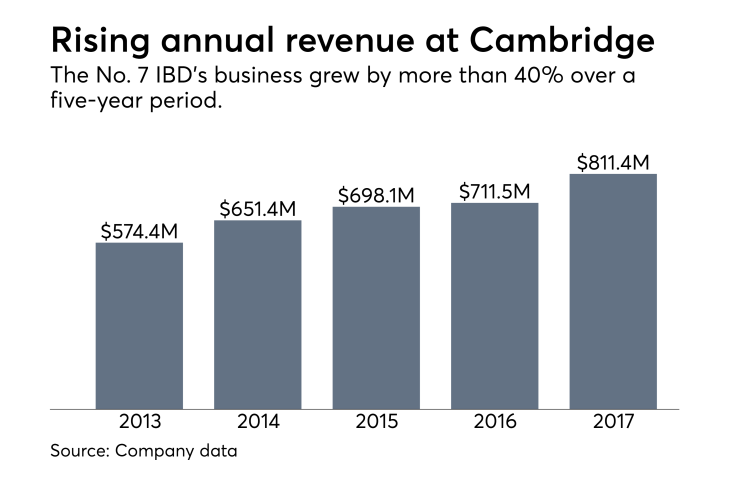The rise of fee-based business in the independent broker-dealer space has prompted one of the largest firms to drop the traditional “office of supervisory jurisdiction” label from its service model for advisors.
The structure of Cambridge Investment Research’s affiliated practices remains the same in terms of compliance oversight, but the Fairfield, Iowa-based firm has become “really more of an RIA than a broker-dealer” because 87% of its advisors are now dually registered, says Chief Risk Officer Seth Miller.
The No. 7 IBD’s advisors no longer associate with terms like “OSJ” and “branch,” according to Miller, who says Cambridge is also studying how best to tailor its approach based on the size of the practices. The firm announced a new approach at its conference for top producers in February which has resulted in five new internal classifications for its practices.

The share of fee-based assets across wealth management grew to 39% in 2016 from 30% in 2010, according
Not all large IBDs have OSJs, and other firms are adjusting, too. Advisor Group’s Woodbury Financial Services, for example, uses home-office supervision and
Cetera, like Cambridge, cited better-customized service to advisors as a reason for the change. Cambridge’s executives have been working on the new approach, which the firm calls “segmentation,” for more than a year, Miller says.
“We’re trying to segment based off not only style of service but size and what the different types of businesses need,” he says, adding that the internal classifications of practices will allow Cambridge to “study them more closely and provide them exactly what they need.”
-
IBDs and regional firms are making the biggest changes, but RIAs have room for growth as well.
April 2 -
The bank’s latest retreat from wealth management will move 51 advisors to the independent space under Woodbury Financial.
April 19 -
Robert Moore divided the firm's six IBDs into two channels, promoted a new COO and hired from a rival.
February 13
Thirteen of the top 25 companies generated double-digit growth in 2017 as rivals close in on the perennial No. 1 firm.
Cambridge now refers to its large teams of 35 advisors or more, which had been known as super OSJs, as “enterprises.” Groups of two to 35 advisors who share certain expenses, technology or offices but operate independently now go by the term “multi-advisor teams.”
The “ensemble” label applies to different kinds of practices which service clients in a combined manner. Cambridge now breaks down such practices into a “solo” segment, an “ensemble” grouping for firms of two to 10 advisors and an “ensemble enterprise” segment for practices with more than 10 advisors.
About a third of the firm’s 3,251 producing advisors work at solo or ensemble firms, another third work on multi-advisor teams or at ensemble enterprises and the last third operate in enterprises, according to Miller.
Cambridge is refining the segmentation strategy, but the firm has already launched new business consulting services for practices of any size. Teams for the home office have also begun visiting large enterprises in recent months to find efficiencies in Cambridge’s service model for them, Miller says.
The reviews have “been received very well, and we’ve actually had some pretty big wins,” he adds.
Cambridge receives high marks of satisfaction among advisors in part because of a “kindness factor” for the Midwestern-based firm when compared to IBDs based in New York and Boston, according to recruiter Jon Henschen.
He also notes approval for Woodbury’s alternate approach with the regional vice presidents rather than the OSJs. Cambridge’s segmentation reminds Henschen of the specific home-office staffers assigned to the so-called Royal Court for the largest practices at another Advisor Group firm, Royal Alliance Associates, he says.
“Their better producers get this specialty service, and they love it. It’s a loyalty driver,” Henschen says. “I’m sure that the Royal Court is an expensive perk for these top producers, but if you want to keep top producers, you need to have perks. You can’t do it on the cheap.”
In an interview in early April, Cambridge CEO Amy Webber recalled speaking on a conference panel with three or four other firms that started as IBDs and four others that began as RIAs. Not one of the representatives for the firms introduced themselves as either an IBD or RIA, though, she says.
Webber and Miller say Cambridge acts as a “financial solutions firm” more than either one of the distinguishing labels. The firm hopes to offer as much flexibility around affiliation and services to advisors as possible, Webber says.
“We’re serving fiercely independent financial advisors,” Webber says. “And the value proposition that you provide needs to align with them.”






